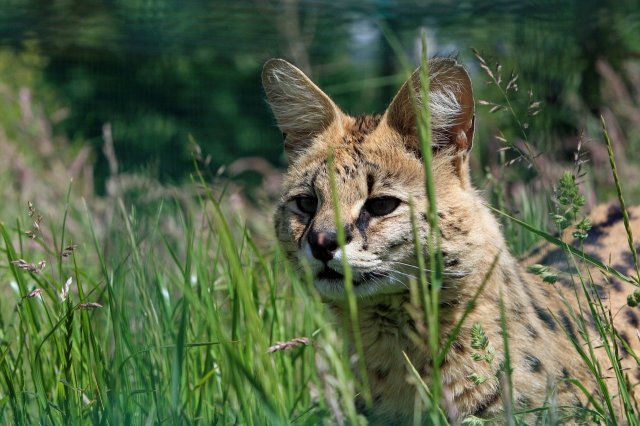10 Ways Loss of Habitat Threatens the African Serval’s Survival
The Majestic African Serval: Awe-Inspiring Beauty and Untamed Grace
The African Serval, scientifically known as Leptailurus serval, is a beautiful and elusive wild cat native to the African continent. With its unique appearance and remarkable hunting skills, the serval has captured the fascination of many wildlife enthusiasts. However, the serval’s survival is under threat due to the loss of its natural habitat. In this article, we will explore ten ways in which the loss of habitat poses a significant danger to the African Serval’s existence.
1. Deforestation
Deforestation, primarily driven by human activities such as logging and agriculture, is a major contributor to the loss of the serval’s habitat. As forests are cleared to make way for farmland or urban development, the serval loses its shelter and hunting grounds. The reduction in forest cover disrupts the delicate balance of the ecosystem, making it harder for the serval to find prey and survive.
2. Fragmentation
The fragmentation of habitat occurs when large areas of land are divided into smaller, isolated patches. This process is often a consequence of human activities such as road construction and urbanization. Fragmentation poses a significant threat to the serval as it restricts their movement and gene flow. The serval’s ability to find mates and establish territories is severely compromised, leading to a decline in their population.
3. Loss of Prey
The serval is a carnivorous predator that primarily feeds on small mammals, birds, and reptiles. The loss of habitat not only affects the serval directly but also impacts its prey species. As their natural habitats are destroyed, the prey population decreases, making it harder for the serval to find food. This scarcity of prey can lead to malnutrition and ultimately threaten the survival of the serval.
4. Human-Wildlife Conflict
As human populations expand and encroach upon the serval’s habitat, conflicts between humans and wildlife become more frequent. Farmers often view the serval as a threat to their livestock and may resort to killing them. This human-wildlife conflict further exacerbates the decline of the serval population, as they are hunted and killed in retaliation for perceived threats.
5. Climate Change
Climate change is a global phenomenon that affects ecosystems worldwide. Rising temperatures, changing rainfall patterns, and extreme weather events can have a profound impact on the serval’s habitat. These changes can disrupt the delicate balance of the ecosystem, affecting the availability of food and water sources for the serval. Additionally, climate change can alter vegetation patterns, making it harder for the serval to find suitable shelter and camouflage.
6. Poaching
Poaching is a significant threat to the survival of many wildlife species, including the African Serval. The serval’s beautiful coat, with its distinctive spots and stripes, makes it a target for illegal wildlife trade. Poachers hunt the serval for its fur, which is highly valued in the fashion industry. The demand for serval pelts drives the illegal hunting and trade, further endangering the already vulnerable population.
7. Habitat Degradation
Habitat degradation refers to the deterioration of the serval’s natural habitat due to pollution, invasive species, and other human-induced factors. Pollution from industrial activities and agricultural runoff can contaminate water sources, making them unsuitable for the serval and its prey. Invasive species can outcompete native plants and animals, further reducing the serval’s available resources.
8. Loss of Genetic Diversity
The loss of habitat and fragmentation of the serval’s population can lead to a loss of genetic diversity. When populations become isolated, they are more susceptible to inbreeding, which can result in reduced fitness and increased vulnerability to diseases. The loss of genetic diversity weakens the serval’s ability to adapt to changing environmental conditions, making them less resilient in the face of threats.
9. Habitat Conversion
Habitat conversion refers to the transformation of natural habitats into agricultural land, plantations, or urban areas. As human populations grow, the demand for land increases, leading to the conversion of natural habitats that are crucial for the serval’s survival. The loss of these habitats leaves the serval with limited options for shelter and hunting, pushing them closer to the brink of extinction.
10. Lack of Conservation Efforts
Despite the numerous threats faced by the African Serval, there is a lack of adequate conservation efforts to protect this magnificent species. Conservation initiatives, such as the establishment of protected areas and the enforcement of anti-poaching laws, are crucial for the serval’s survival. Without these efforts, the serval’s population will continue to decline, and their existence will be in jeopardy.
Summary
The loss of habitat poses a significant threat to the survival of the African Serval. Deforestation, fragmentation, loss of prey, human-wildlife conflict, climate change, poaching, habitat degradation, loss of genetic diversity, habitat conversion, and the lack of conservation efforts all contribute to the decline of this remarkable species. It is imperative that we take immediate action to protect the serval’s habitat and ensure its long-term survival. By addressing these threats and implementing effective conservation measures, we can secure a future for the African Serval and preserve the biodiversity of our planet.
Read More About Servals From Wikipedia




